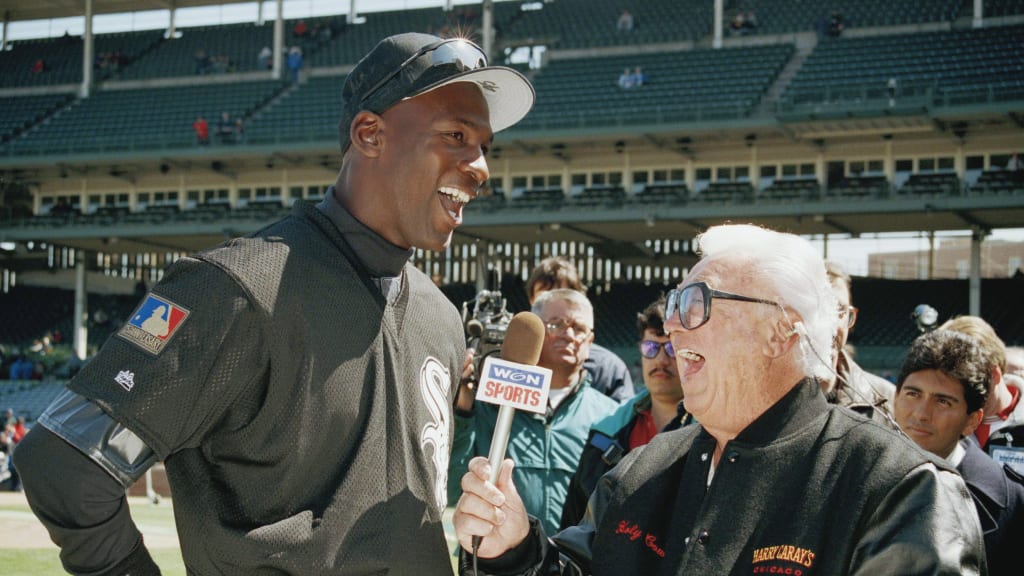
There’s nothing like a great baseball story. But baseball has been around a long time, and in some cases, it can be hard to tell whether those stories are too good to be true. Which is why MLB Mythbusters is here to help -- we'll be diving into some of the game's greatest legends, trying to separate fact from fiction.
Next up: Revisiting the most famous season in Minor League history.
The Myth: Michael Jordan's stint with the Birmingham Barons was an embarrassment, well-meaning but so ill-conceived that it sent him back to the NBA after a single humiliating season.
The context: On Oct. 6, 1993, Michael Jordan did the unthinkable. Still mourning the tragic murder of his father that August, the greatest basketball player of all-time announced that he'd be stepping away from the sport, right in the middle of his prime, after winning a third straight NBA championship. He no longer had a “sense of motivation," he said, "the sense to prove something as a basketball player.”
What exactly did he want to do next? He didn't say, but privately he'd already told Bulls and White Sox owner Jerry Reinsdorf that he'd been thinking about playing a different sport: baseball, his dad's greatest love. Over the winter, he worked out with several White Sox coaches and players. In early February, he signed with Chicago and got set to report to Spring Training.
If you know anything about Jordan's stint as a baseball player, you probably know it as a failure -- a PR charade, a very famous and very confident man thinking that he could do anything he wanted, only to realize slowly and painfully that he couldn't. Even "Space Jam" treated it as a punchline, a never-ending string of indignities from awkward strikeouts to getting mercilessly roasted by Jim Rome.
That narrative had set in before Jordan even played an official game: The March 14, 1994, issue of Sports Illustrated immortalized the image of MJ flailing helplessly at a breaking ball, complete with a plea to "Bag It, Michael!" (The headline on the story inside: "Err Jordan.")
It's not hard to see why. Major League lifers resented someone using their stature to cut the line. "What'd he hit in high school, .280?" an anonymous AL manager asked SI. "Pathetic. I've got players in my clubhouse who are only now starting to hit after living and breathing baseball for 15 years, and this guy thinks he can become a hitter in a couple of months. It's a disgrace to the game."
The public, in its own way, wasn't much more forgiving. It didn't matter that hitting professional pitching was and is one of the very hardest things in sports, or that Jordan hadn't picked up a bat in nearly 15 years (he was declared ineligible for his senior season at Laney High School after playing in the McDonald's All-American Game that April, effectively ending his baseball career at the age of 18). This was His Airness -- probably the most famous man in America, an icon whose every move got imitated in backyards everywhere, whose name and image had become synonymous with greatness. And he'd given it all up for a life of 12-hour bus rides and $10 per diems.
Everywhere he went, a horde of cameras and fans followed, and the subtext was pretty clear: If you're going to deprive us of the Michael Jordan of basketball, you better become the Michael Jordan of baseball.
The argument for: That, to put it kindly, is not what happened. Despite all those hours in the cage over the winter, Jordan struggled in his first Spring Training, picking up just seven hits in 46 at-bats split between Chicago's Major and Minor League camps. His swing was rusty, and he was trying to adjust to the best pitching on the planet on the fly in front of a national audience. Even the good moments -- like his RBI double at Wrigley Field in an April exhibition game against the Cubs -- looked pretty awkward:
Yet the White Sox still gave him an aggressive assignment to start the year: the Double-A Birmingham Barons, putting Jordan shoulder-to-shoulder with some of the best prospects in the game (like, for example, Darren Oliver, the first pitcher MJ ever faced in an official game). To everyone's surprise, though, he started the season strong, reeling off a 13-game hitting streak that brought his average all the way to .327 by late April.
Then things got ... much harder. After a few weeks of mostly fastballs, pitchers started feeding Jordan a steady diet of breaking balls the likes of which he simply hadn't seen before -- "he didn't see a fastball in the strike zone for probably a month and a half," Mike Barnett, the Barons' hitting coach at the time, once recalled. The hitless nights began to pile up, as did the strikeouts. According to his manager, Terry Francona, Jordan even thought about quitting: We had a conversation in Memphis," Francona told Complex in 2017. "I think he was pretty down. It was probably three months into the season, and it was hard for him. He wasn’t seeing the games he wanted to see."
When the dust settled at the end of the year, the numbers were downright ugly: a .202/.289/.266 slash line (for comparison, Jacob deGrom hit .200/.246/.323 in 2019) with just three homers and 21 total extra-base hits in 127 games. No other Barons regular even had an OPS below .600, but Jordan's sat at .556. He wasn't just the worst hitter on the team -- he was the worst hitter in the Southern League, and it wasn't really close.

Plenty of people involved, from Francona to White Sox bench coach Joe Nossek, swore that he had the talent and work ethic to make it, that he could be a Major Leaguer. But what else could they say; were they really about to trash America's most prominent athlete and their organization's most prominent employee? Plenty of others -- like Kenny Lofton, who met Jordan in Spring Training in 1994 -- thought he had no shot, that it was a well-meaning exercise in futility.
By March of 1995, with MLB still on strike, Jordan finally decided he'd had enough. With a simple two-word statement, he announced that he was returning to the Bulls. He'd go on to win another three titles, and his year spent trying to make it in baseball became something between a fever dream and a sideshow.
The argument against: Of course, if Jordan was easily the worst hitter in the Southern League, he was also the only hitter in the Southern League who hadn't swung a bat in 14 years, and who had never laid eyes on professional pitching until March. All the athleticism in the world won't help you identify spin, or get your timing down, or do any of the million little things it takes for hitters to become Major League hitters.
MJ had so far to go. Just ask Bob Herold, his outfield coach in the Arizona Fall League:
The first time I saw him fielding, he looked like a 5-year-old going for fly balls, catching everything on the run with two hands. I told him, “A big man like you has to catch those on the side, with one hand.” And he said, “That’s how my dad taught me, catching everything with two hands. That’s how you play the game right.” Sure, if you’re standing still. And I’m wondering, I’m really the first guy to tell this guy how to catch the ball right?
He literally didn't know how to properly catch a fly ball! Expecting immediate success -- or, heck, even immediate competence -- was like plopping someone down in France and expecting them to start effortlessly speaking the language. The question was never whether Jordan would be bad. The question was just how bad would he be, and could he get better?

Ugly box scores aside, the answer to the latter sure seemed to be a resounding yes. For starters, the tools were readily apparent: Despite having to learn the art of basestealing on the fly, at age 31, against seasoned professionals and top prospects who were keyed in on him, Jordan still swiped 30 bags in 48 tries -- a 62.5-percent success rate, on par with what guys like Austin Meadows and Amed Rosario did last year. "Michael Jordan was a Major League-caliber athlete" is head-smackingly obvious, but he'd already started translating that into games.
Even at the plate, where he received all sorts of scorn, things weren't as bad as you probably think. Again, it's understandable that MJ would flounder early in the year, considering everything he had to adjust to. But he improved considerably as time went on: All three of his homers came over the final month of the season, and they show somebody who was starting to look like an honest-to-god baseball player.
Even the writer of that infamous "Err Jordan" piece started to come around. "I realized I had been wrong," Steve Wulf wrote last year. "He had a big league swing with bat speed, and he was working his butt off ... I decided to write a mea culpa. The SI editors read the piece, then told me to bag it."
Jordan closed the year with 12 hits in his final 40 at-bats, including three multi-hit games to push his average back up over the Mendoza Line. He then spent much of September and October in the AFL, competing with a collection of the best young talent in the game, and managed to hit .252 over 123 at-bats.
A guy with legitimate 30-steal speed and improving hit tool who can play multiple outfield spots and get on base reasonably well (Jordan's 10.3-percent walk rate would've placed him 44th among qualified hitters last year, just behind Pete Alonso) -- that sounds like the outline of a fourth outfielder, no? Not to mention the fact that, back in March, he looked like a guy struggling just to move like a baseball player.
The verdict: Maybe ".250 in Double-A" was Jordan's ceiling. Maybe he never would've figured out Major League pitching, never would've really grown comfortable with his swing. But think about the distance he'd covered in just his first eight months of meaningful baseball experience. Think about his work ethic: Barnett claimed that he "would go after it five times a day," including after games, to the point where his hands were blistered and bleeding, because this is Michael Jordan we're talking about. Then think about the fact that this is the same guy who was gifted enough to come back and lead his Bulls to the NBA title in 1996.
Really, we should view Jordan's baseball career the way we do another sports icon turned Minor Leaguer: Tim Tebow. Like Jordan, Tebow signed with the Mets amid plenty of doubts about his age and ability to hang in pro ball. Like Jordan, he struggled at first, hitting .194 in the AFL and then posting a .656 OPS between two levels of Class A in 2017. But he stuck with it, he got better, he harnessed some of his tools and he at the very least proved that he wasn't a joke. No one thinks that Tebow is a future big league star, but everyone acknowledges the difficulty of what he's done, and there's nothing to suggest that MJ wouldn't have been able to do the same.
